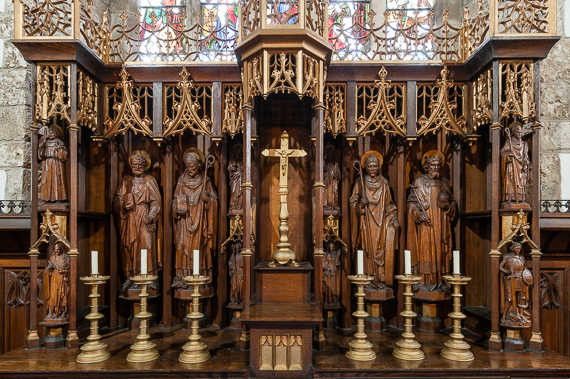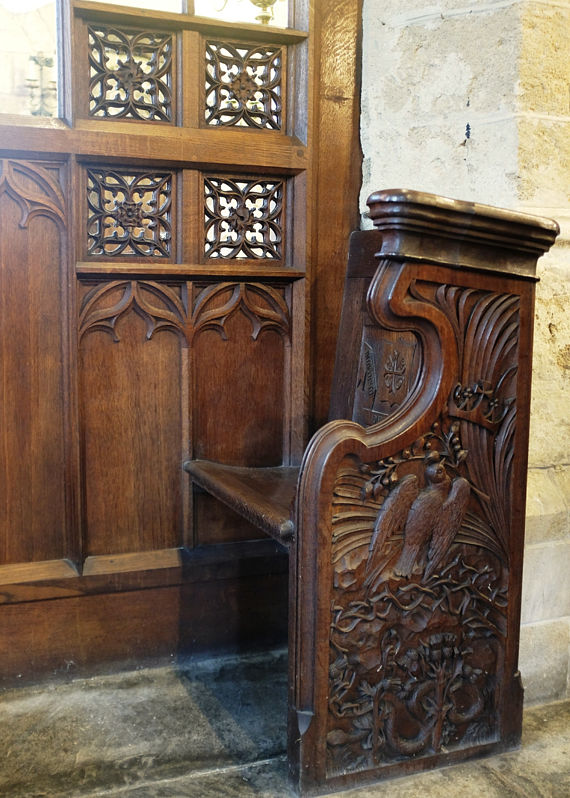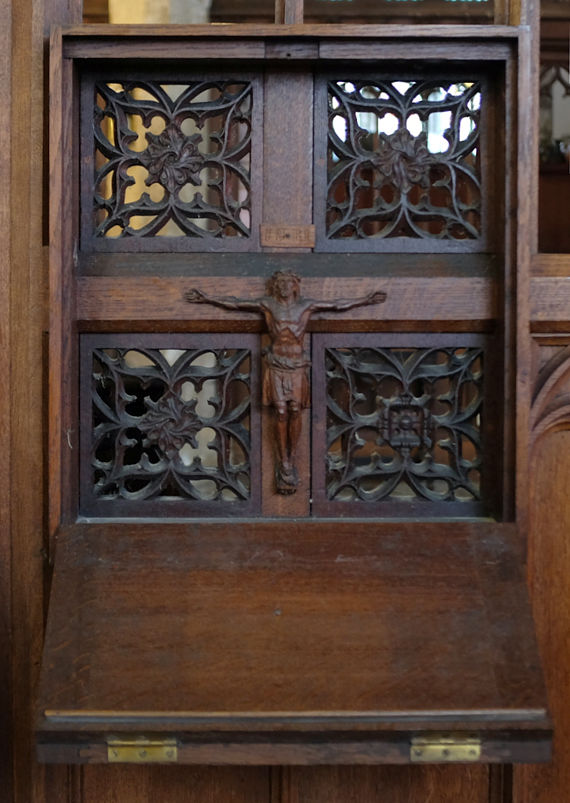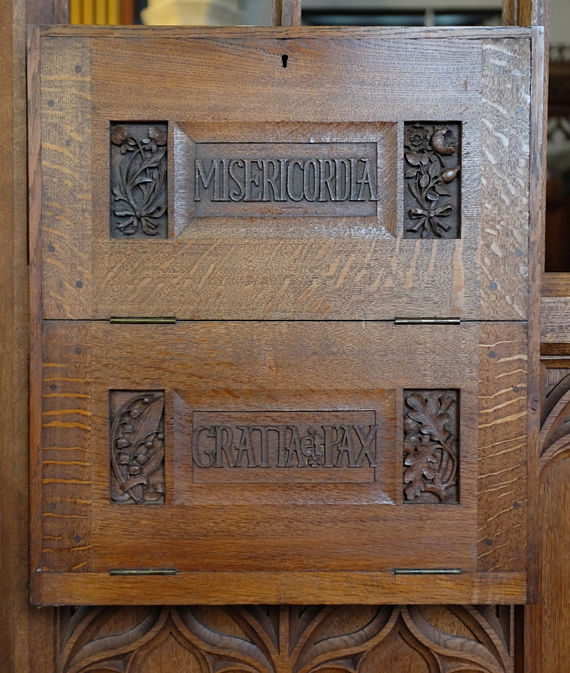St Carantoc
A most remarkable restoration of this church was carried out between 1899 and 1907 to plans by Edmund H. Sedding, with the internal woodcarving expertly and beautifully executed by the Pinwill company. According to the guide (Brown & Hattam, 1996), the walls and roof were first made secure, and then the chancel beautified with marble flooring and carved oak furnishings. Then the full width screen was fitted, and the church reopened in July 1902, while the benches were completed in 1907. The first stage of this work was carried out in the period of Rashleigh, Pinwill & Co., but continued into the time when Violet became the sole proprietor and the benches are attributable to her.
Reredos – Photograph (PWDRO 116/71 & 244/5); 1899-1902

The elaborate reredos is not shown in a separate photograph but features in ones of the chancel. Beneath canopies are niches for four large and eight small figures of Saints, although these were not produced until later. In May 1902 the reredos was placed on exhibition for one week at the art gallery of Harris & Sons in George Street, Plymouth. This was reported in the West Briton (1902), together with a full description and the information that it was designed by E. Sedding and executed by Rashleigh Pinwill.
Sanctuary Panelling, Aumbry and Door – Photograph (PWDRO 116/71); 1899-1902
Choir Stalls – Photograph (PWDRO 116/71 & 244/5); 1899-1902
Clergy Stalls – Photograph (PWDRO 244/5); 1899-1902
Vicar’s Stall – Photograph (PWDRO 244/5); 1899-1902
The chancel stalls are notable for their exuberant poppy heads, featuring trees, seaweed, fruit and flowers. The Vicar’s stall has a tree within which sits the dove of St Carantoc. All the seats have carved misericords, the ones under the four clergy stalls showing the sacraments of Baptism, Confirmation, Penance and Holy Communion (Brown & Hattam, 1996).
Parclose Screens (4) – Photograph (PWDRO 116/71 & 244/5); 1899-1902
The parclose screens are shown in situ in photographs at PWDRO. On plans for the screens it is stated by Sedding ‘2 old ones to be rest’d & 2 new ones’ (Kresen Kernow X272/14/13).
Confessional and Priest’s Seat – Church Inventory of Restoration Work; 1899-1902
In the Lady Chapel, incorporated into one of the new parclose screens, is a pair of hinged panels bearing the words ‘Misericordia Gratia et Pax’ (Mercy, Grace and Peace) that fold down to reveal a carved grill used for confessions. On the opposite side of the screen, within the chancel, a seat was provided for a priest to hear the confessions.
Rood Screen – Photograph (PWDRO 116/71, 244/4 & 244/5); 1899-1902
The screen incorporates several uprights of the medieval screen and features figures of the apostles and evangelists. Beacham & Pevsner (2014 p. 166) describe the screen as ‘especially accomplished’.
Rood Base – Photograph (PWDRO 116/71); 1899-1902
Placed upon the screen is a rood, the figures of which were carved at Oberamagau, but the base was made by the Pinwill company.
Bosses – Photograph (PWDRO 244/4 & 244/5); 1899-1902
Lectern – Photograph (PWDRO 244/4 & 244/5); 1899-1902
Lady Chapel Altar Panels – Plan (Kresen Kernow X272/14/8); 1899-1902
Figure of St Michael – Church Inventory of Restoration Work; 1899-1902
A figure of St Michael in an elaborate corner canopy sits on the wall in the Lady Chapel. There are some strong similarities between this figure and the one made for Lew Trenchard at around the same time, except that the scales with which St Michael is often associated are not included in the Crantock carving.
In July 1902, when the chancel and screen were complete, the church was re-opened in a service of dedication conducted by the Bishop of Truro and reported in the Church Times (1902). The effect was described as being ‘as if the rarest art and genius have combined to make this House of God as fair as any in the land’ (Ibid. p. 62). It was also reported that the figures for the reredos were not, at that stage, in place. In a description of the church it is mentioned that a carved stone statue of St Carantoc opposite the doorway was made by the sculptor Nathaniel Hitch, with whom Violet Pinwill and Edmund Sedding had several collaborations.
Desk Fronts – Warner (2022); 1904
Two carved oak desk fronts were installed in 1904 as a commencement towards the reseating of the church (Warner, 2022). A photograph (PWDRO 244/5) of the interior of the church after the completion of the first stage of the restoration in 1902 shows these desk fronts and rows of chairs that were used before benches were added in 1906/07.
Pulpit – Photograph (PWDRO 244/5); 1904
There is a plan by Sedding for a pulpit for Crantock (Kresen Kernow X272/14/14) but it is not the one that was made. In a photograph of the interior prior to the benches being installed, there is a pulpit matching the one that is presently in the church. It was completed in 1904 at a cost of £45 15s (Warner, 2022). This pulpit is the earliest of several very similar ones made by the Pinwill company for other churches around Cornwall, being octagonal with heavily carved uprights and eight legs.
Lady Chapel Altar Rails – Photograph (PWDRO 244/5); 1905
The altar rails in the Lady Chapel were not added until 1905 and cost £25 (Warner, 2022).
Figures for Reredos – Photograph (PWDRO 244/5); 1905
These figures were not in place at the time of the dedication service (Church Times, 1902) but were completed by February 1905 and put on display at an exhibition of work by Rashleigh, Pinwill & Co. in Plymouth (Western Morning News, 1905). These consisted of four large figures of St Peter, St Patrick, St Piran and St Edward the Confessor, along with eight smaller ones to represent the beatitudes, namely St Francis, St Anselm, St Mary Magdelen, St Teath, St Bridget, St Agnes, St Trenaens and St George.
Benches and Bench Ends – Guide (Brown & Hattam, 1996); 1906-07
The nave was re-seated 1906-07 at a cost of £230 (Warner, 2022). There are 18 carved bench ends running in two series, one showing scenes in the life of Christ, and the other the teaching of the Church. These carved ends ‘follow, in section and design, those so ruthlessly destroyed in the 18th century. It was found impossible to work in even fragments of these, but the new work is of quite equal merit and dignity’ (Royal Cornwall Gazette, 1907).
Postcards sent from Crantock by joiner Albert E. Elliott to his wife demonstrate that the work of installing the benches took over three weeks, probably because the benches themselves needed to be cut in situ to fit individually.
Lych Gate – Plan (Kresen Kernow X272/14/4) E.H. Sedding architect; 1899-1902
A plan by Sedding held at Kresen Kernow is for a new lych gate, but whether the Pinwill company was involved in this work is not known.
Sources
Beacham, P. & Pevsner, N. (2014) The Buildings of England. Cornwall. Yale University Press, London.
Brown, M. & Hattam, M. (1996) The Parish Church of St. Carantoc Crantock Cornwall.
Church Times (1902) The Re-Opening of Crantock Church. 18 July p. 62.
Kresen Kernow X272/14/4 Plan. Crantock. Lych Gate.
Kresen Kernow X272/14/8 Plan. Crantock. Lady Chapel Altar Panels.
Kresen Kernow X272/14/13 Plan. Crantock. Parclose Screens.
Kresen Kernow X272/14/14 Plan. Crantock. Pulpit.
PWDRO 116/71 Photographs. Crantock. Chancel, Screen, Rood and Exterior.
PWDRO 244/4 Photograph Album. Various. Woodcarvings.
PWDRO 244/5 Photograph Album. Various. Woodcarvings.
Royal Cornwall Gazette (1907) Crantock. 27 June p. 7.
Warner, M. (2022) A Time to Build: Signposts to the Building, Restoration, Enhancement, and Maintenance of Cornwall’s Anglican Churches and Mission Rooms. Scyfa, Cornwall.
West Briton (1902) Local Intelligence. Newquay. 1 May p. 5.
Western Morning News (1905) Exhibition of Wood-Carving in Plymouth. 15 February p. 8.


